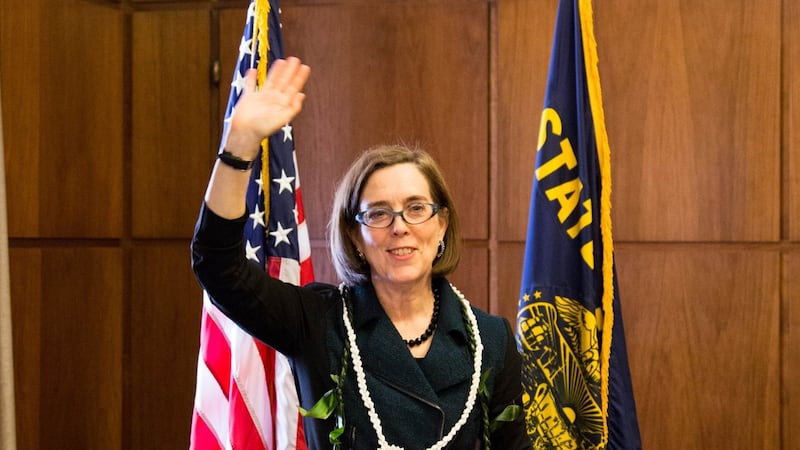Gov. Kate Brown, sworn in today as Oregon's 38th governor, gave her inaugural speech to a joint session of the Legislature today and offered a mish-mash of ideas—some specific, some vague, but few bold or surprising.
A former juvenile rights lawyer, Brown was at her most eloquent in her defense of equal rights for everyone.
"America has just come through the most bitter and divisive national election in memory; an election featuring rhetoric questioning the very citizenship and civil rights of Americans," she said. "And I want to make it very clear that here in Oregon, where thousands have fought for and demanded equality, we can not and will not retreat."
Without mentioning President-elect Donald J. Trump by name Brown offered a full-throated rebuttal to many of the ideas he pushed in his campaign.
But in regard to the biggest story of the Oregon election—the 19 point defeat of Measure 97, the proposed $3 billion tax increase—she spoke only obliquely.
"Under my direction, my office will work with stakeholders on potential options to generate the revenue we need so badly," Brown said.
But she did not offer any specifics about how that revenue might materialize, either through economic expansion or new taxes.
One bright spot she cited was the new Oregon Manufacturing Innovation Center in Scappoose, which the governor says has already attracted interest from a dozen companies.
For the rest of rural Oregon, however, she dusted off the prospect of a time-honored Oregon practice—public works.
"There is an opportunity to create jobs right now. That opportunity is in the 135 bridges we have on our coast," Brown said. "Let's create more good-paying, family-wage jobs in Coos and Curry counties and all along Highway 101 by investing in seismic retrofitting of our coastal roads and bridges."
She wants to do the same thing on U.S. 97, an increasingly busy north-south highway east of the Cascades.
The Oregon Department of Transportation, which would do the bridge work, is broke, in part because of a massive bridge reconstruction program it embarked on in the past decade.
Brown was clear about her view of the state's finances.
"For longer than I have served in government, Oregon has faced a revenue shortfall—a little less painful in good times, catastrophic in bad times. We have cut and we have squeezed. Our roads, our public safety, and our schools have paid the price," she said.
The governor said she's not much interested in exploring options that would significantly reduce the state's $22 billion pension deficit.
"We must address the ongoing PERS liability in a way that keeps our promises to retirees and does not put us back on an endless hamster wheel of litigation," Brown said. That's a reference to previous attempts to cut costs, the most recent of which were largely rejected by the Oregon Supreme Court.
Brown's lack of interest in reducing pension costs may be a problem for some members of the business community, who are pressing for some reduction in exchange for supporting tax increases.
Brown made only a vague acknowledgement that reducing the cost of government is a possibility—and not one that figures much into her strategy for this year.
"To identify best practices and make recommendations in time for the 2018 legislative session, I am appointing a panel to engage with stakeholders in both the public and private sectors," she said. "The panel will make recommendations on how state government can operate more efficiently, streamline the services that support our economy, and bolster the services that our vulnerable families depend on."
Brown could save herself and her panel a lot of trouble by dusting off former Gov. Ted Kulongoski's "Reset Report" which in 2010 diagnosed the structural problems that create a perennial budget deficits. They haven't changed much since then.
In a nod to bipartisanship, Brown began her speech by quoting former Gov. Tom McCall and ended it by quoting former Gov. and U.S. Sen. Mark Hatfield, both Republicans.
In concert with her speech, Brown also released a legislative agenda that almost makes up in brevity what it lacks in ambition.
After a quarter-century in elected office and nearly two years as governor, Brown wants to focus on these four policies: increasing the high school graduation rate; improving the state's transportation system; increasing gun safety; and, increasing children's access to healthcare.
All are worthwhile, although in her speech, Brown noted nearly all Oregon children already have access to health care.
"We have made great progress in the equitable delivery of health care," Brown said. "Over the past several years, Oregon has expanded health care to 95 percent of adults and 98 percent of children."
Nobody would deny that trying to gain coverage for the other two percent is a laudable goal but it is the very definition of incrementalism—the theme of today's speech.
